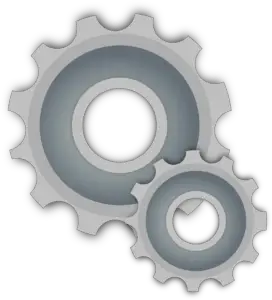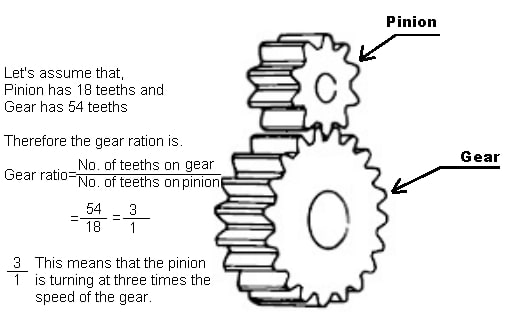In this post, you will learn what is gear ratio in gears? and how to calculate the gear ratio. Also, you can download the PDF file at the end of this article.
Gear Ratio
The gear ratio is the ratio of the number of turns the output shaft makes when the input shaft turns once. In other words, the Gear ratio is the ratio between the number of teeth on two gears that are meshed together, or two sprockets connected with a common roller chain, or the circumferences of two pulleys connected with a drive belt.
Don’t miss out: What are the Types of Gear Cutting Process? Their Advantages, Disadvantages [PDF]
How Gears Transmit Power
The tooth and wheel of the gear are basic workings parts of all types of gears. The different types of gear are used to execute the transfer of energy in a different direction. For instance, when two gears of different sizes mesh and rotate, the pinion will turn faster and with less torque than the larger gear.

The teeth of the gear are principally carved on wheels, cylinders, or cones. Many devices that we use in our day-to-day life there working principles as gears.
Often gears that are meshed together will be of different sizes. In this case,
- The smaller gear is referred to as the pinion and
- The larger one is simply referred to as the gear.
Gear is different from a pulley. Gear is a round wheel that has teeth that mesh with other gear teeth, allowing the force to be fully transferred without slippage.
To overcome the problem of slippage as in belt drives, gear is used which produces a positive drive with uniform angular velocity. When two or more gears mesh together the arrangement is called a gear set or a gear train.
Read about: Gear Terminology [This is one of the Easiest Guide on Gears]
Gear Ratio Calculation
For example, a pinion with 18 teeth is mounted on a motor shaft and is meshed with a larger gear that has 54 teeth.
During operation, the pinion makes three complete revolutions for every single revolution of the larger gear.
This relationship in which the gear turns at one-third of the pinion speed is a result of the number of teeth on the pinion and the larger gear. This relationship is called the gear teeth – pinion teeth ratio or the gear ratio.

This ratio can be expressed as the number of gear teeth divided by the number of pinion teeth. So in this example, since there are 54 teeth on the larger gear and 18 teeth on the pinion. There’s a ratio of 54 to 18 or 3 to 1 this means that pinion is turning at three times the speed of the gear.
Now often more than one gear set is used in a gearbox multiple gear sets may use in place of one large set because they take up less space.
However, the gear ratio can still be used to determine the output of a gearbox.
Example of Gear Ratio
Let’s see how this illustration consists of two gear sets. This gear set has a pinion with 10 teeth and a gear with 30 teeth. The second gear set consists of an opinion with 10 teeth and a gear with 40 teeth.

In our example, the input shaft is turned by an external device such as a motor. And the output shaft is connected to a machine to drive, such as a pump or a fan it’s often called the output shaft.
The input shaft and output shaft are connected by the intermediate shaft.
Now by using the gear ratio formula we looked at earlier, we can determine the ratio across the gears. The first gear set is 30 over 10 or 3 to 1. And that the ratio across the second gear set is 40 over 10 or 4 to 1. This information can be used to determine the ratio across the entire series of gears.
That’s done by multiplying the ratio of the first gear set by the ratio of the second gear set.
So 3 / 1 times 4 / 1 results in a ratio of 12 / 1 this means that for every 12 revolutions of the input shaft the output shaft will complete one revolution. Or in other words, the motor shaft is turning 12 times faster than the pump shaft.
Well, so far we’ve looked at how a speed can be changed across the gear set and we’ve seen how this change can be described by you.
Gear ratios can be used to determine the speed of rotation of a gear set if the input or output speed of the gear set is known.
Download PDF of this article:
That’s it.
If you find this article helpful share it with your friends. Have any doubts or questions about “Gear Ratio” leave a comment I’ll respond.
Subscribe to our newsletter to get notification of new articles:
Read more on our blog:
Shaper machine, Drilling machine, Planner machine, and more.
Great post! I always found gear ratios a bit confusing, but your explanation and formula made it so much clearer. Thanks for breaking it down so simply!
Thank you! I’m glad the explanation helped clear things up for you! 😊
Great learning
Thanks.
There is an error in your diagram showing Gear ratio = #teeth on pinion / # teeth on gear
Should be Gear ratio = #teeth on gear / # teeth on pinion.
You calculate correctly afterwards but the equation presented should also be corrected.
Thank you so much for letting me know, I’ve changed the image now you can see it, and thanks for reading 🙂
thanks for your clear explanation (for us gear head wanna be’s).
you’re welcome
Best information is provided by your site. I always go for your post Engeers Post to clear my concepts in easy way. Keep it up
Thank you so much 🙂